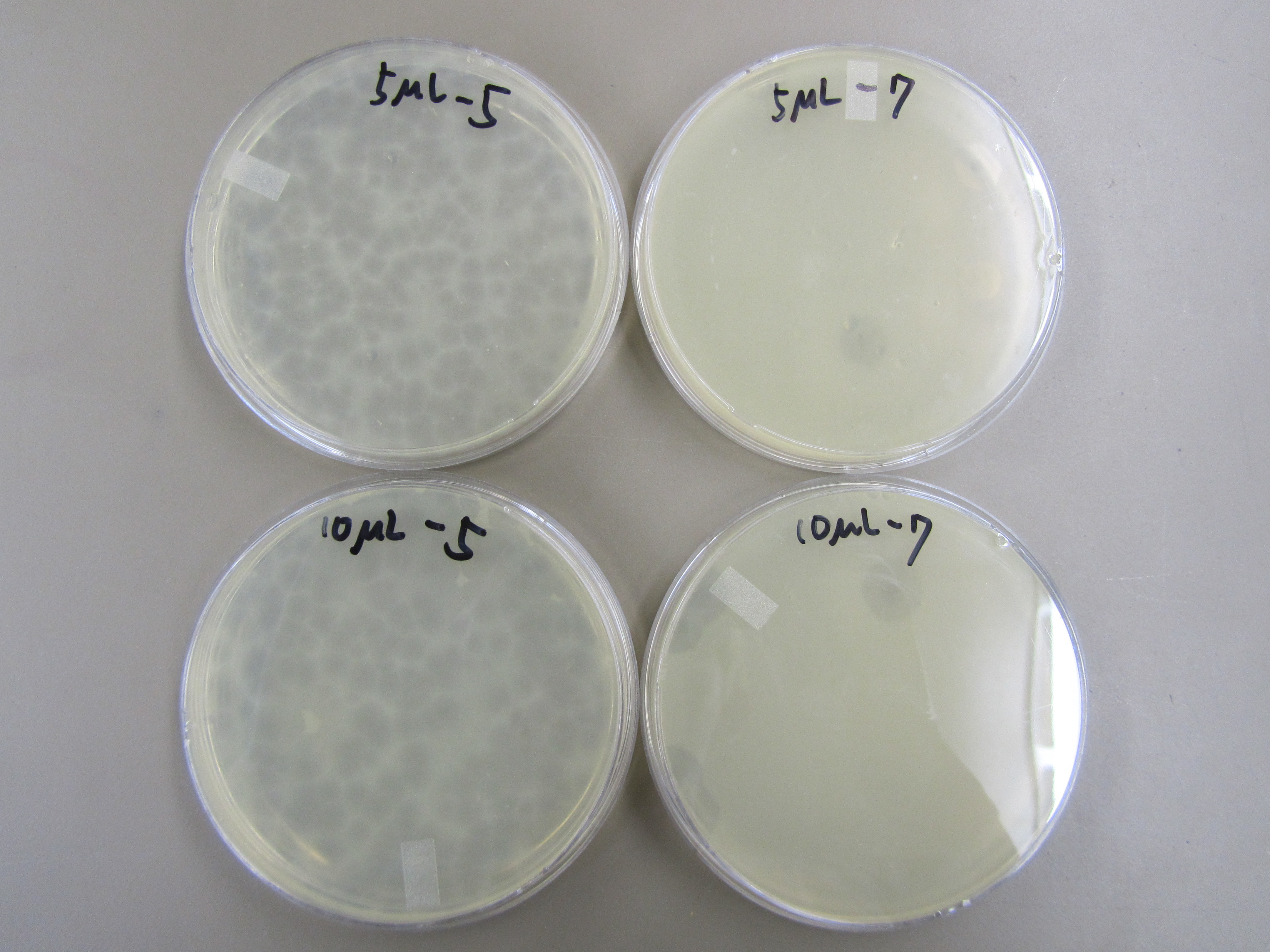|
- Small Phage
- March-April
- May-June
- July-August
- September-October
|
7.13 Phage Propagation Experiment
I) Purpose
- To amplify the 5.3 phage stock solution we have been using for mutagenesis and determine an accurate titer for future mutagenesis.
II) Expected Outcome
- A purified high titer of phage. The new stock should have a higher titer than the 5.3 phage stock, which decreased in phage viability due to sitting in the fridge for 2 month.
III) Reagent Record
- Chloroform from Dr. Grose’s lab; LB; E coli BL21 liquid culture overnight; x8 top agar; x2 top agar; 5.3 phage stock
IV) Actual Procedure/Observations
- 1. Set up phage liquid culture - first round of propagation(7.13)
- - phage: 4mL LB + 1mL E coli
- 10uL phage: 4mL LB + 1mL E coli + 10μL 5.3 phage stock
- 100uL phage: 4mL LB + 1mL E coli + 100μL 5.3 phage stock
- :1mL phage: 4mL LB + 1mL E coli + 1mL 5.3 phage stock
- 2. Liquid culture purification 1(7.15)
- 1) For each infected test tubes (10uL, 100uL, 1mL), put 1mL of liquid culture into 5 eppendorf tubes.
- 2) Centrifuge at 3000 rpm for 5 minutes
- 3) Transfer supernatant into new eppendorf tubes. 5 eppendorf tubes for each phage concentration.
- 4) Add 100 uL of chloroform to each of the new tubes and gently shake
- 5) We labeled the purified stock as 7.15
- 3. Titer to determine phage concentration 1(7.15)
- 1) For each concentration of phage, specifically 10uL, 100uL, and 1mL, 1:100 dilution series were performed to generate 0, -2, -4, -6. 1:10 dilution series were then performed to generate -7, -8, and -9.
- 2) For each dilution, a test tube was assigned to it. To each test tube, 0.75mL of BL21 liquid culture overnight was added and then transfected with 30uL of phage dilution. After 20 minutes of incubation, 7mL of x8 agar was added to each test tube and the content was then plated.
- 3) Plates were incubated upside down for 24 hours.
- 4. Set up phage liquid culture - second round of propagation (7.17)
- - phage: 4mL LB + 1mL E coli
- 5uL phage: 4mL LB + 1mL E coli + 5μL 5.3 phage stock
- 10uL phage: 4mL LB + 1mL E coli + 10μL 5.3 phage stock
- 5. Liquid culture purification 2 (7.19)
- 1) For each infected test tubes (5uL and 10uL), put 1mL of liquid culture into 5 eppendorf tubes. (The 5th eppendorf tube for each culture only had about 0.75mL).
- 2) Centrifuge at 3000 rpm for 5 minutes.
- 3) Transfer supernatant into new eppendorf tubes. 5 eppendorf tubes for each phage concentration.
- 4) Add 100 uL of chloroform to each of the new tubes and gently shake.
- 5) We labeled the purified stock as 7.19.
- 6. Titer to determine phage concentration 2 (7.19)
- 1) For each concentration of phage, specifically 5uL and 10uL, 1:100 dilution series were performed to generate 0, -2, -4, -6. 1:10 dilution series were then performed to generate -7, -8, and -9.
- 2) For each dilution, a test tube was assigned to it. To each test tube, 0.75mL of BL21 liquid culture overnight was added and then transfected with 30uL of phage dilution. After 20 minutes of incubation, 7mL of x1 agar was added to each test tube and the content was then plated.
- 3) Plates were incubated upside down for 24 hours.
V) Results
- 3. Titer to determine phage concentration 1
- 10ug has many plaques on the -4 plate and 6 plaques on the -6 plate.
- 100ug has many plaques on the -4 plate, none on the -6 plate, and 1 on the -7 plate.
- 1mL has many plaques on the -4 plate, 4 on the -6 plate, and 2 on the -7 plate
- We realized afterwards that using x8 top agar will not give us an accurate measure of phage concentration. From our results in 4.26 T7 Phage Selection Test, we know that the more concentrated the top agar is, the fewer the number of plaques will form on each plate. Thus for our next titer, we will use x1 agar.
- 4. Set up phage liquid culture - second round of propagation
- The 10ug test tube was pretty clear, while the 5ug test tube was a little cloudy. The 0ug test tube was still very cloudy.
- 6. Titer to determine phage concentration 2
- Both 5ug and 10ug went down to -7. They appear to be at about the same concentration.
VI) Conclusion/Next Step
- After these two round of propagation, we are able to increase the titer of our phage stock to 10^(-9) PFU/mL. We will use this as the new stock for our future round of mutagenesis. Also, this experiment made us realize that phage titer will drop if it is stored inside the fridge for too long. This requires us to perform a titer periodically in the future to test for the viability of our phage stock.
|

 "
"